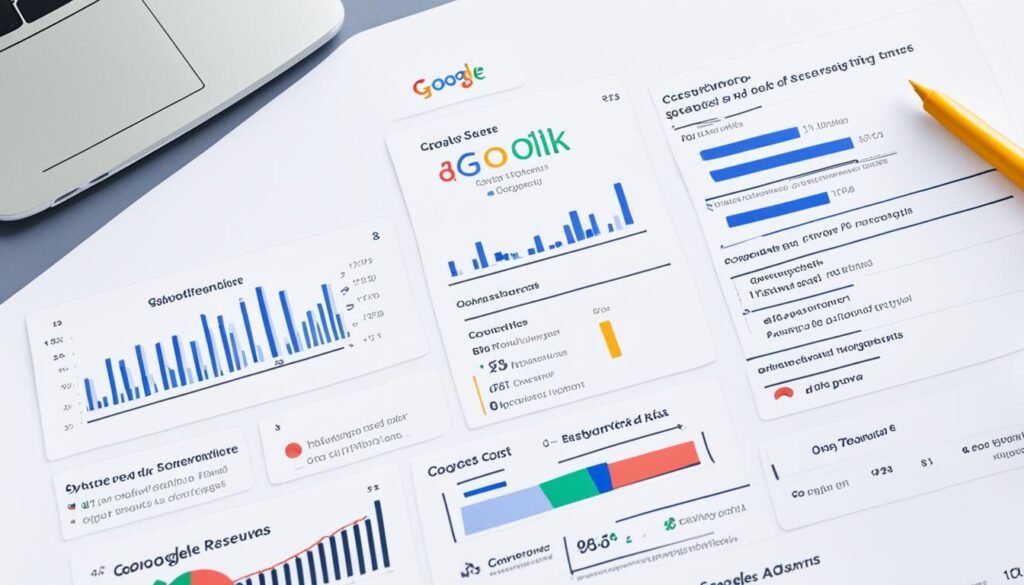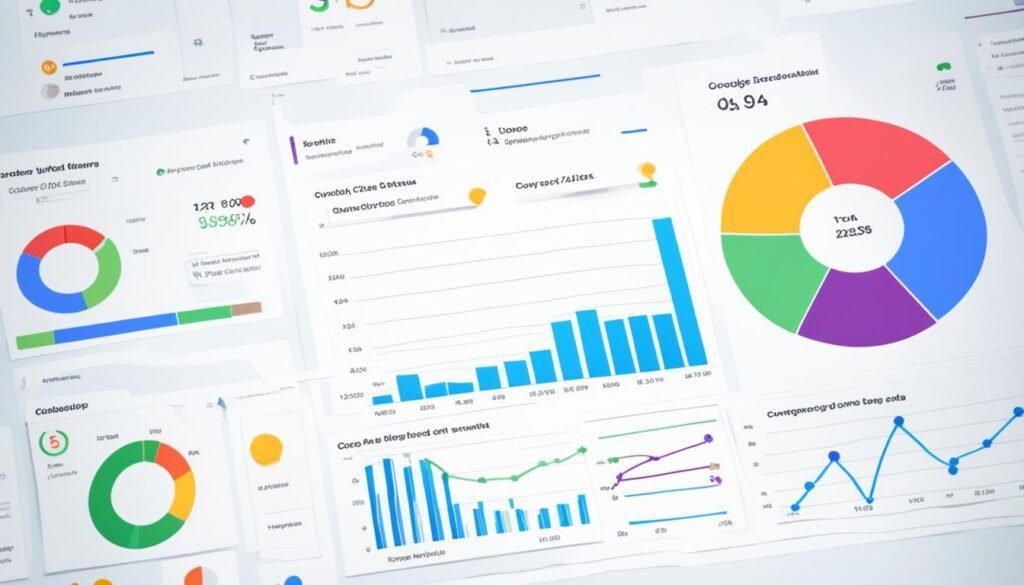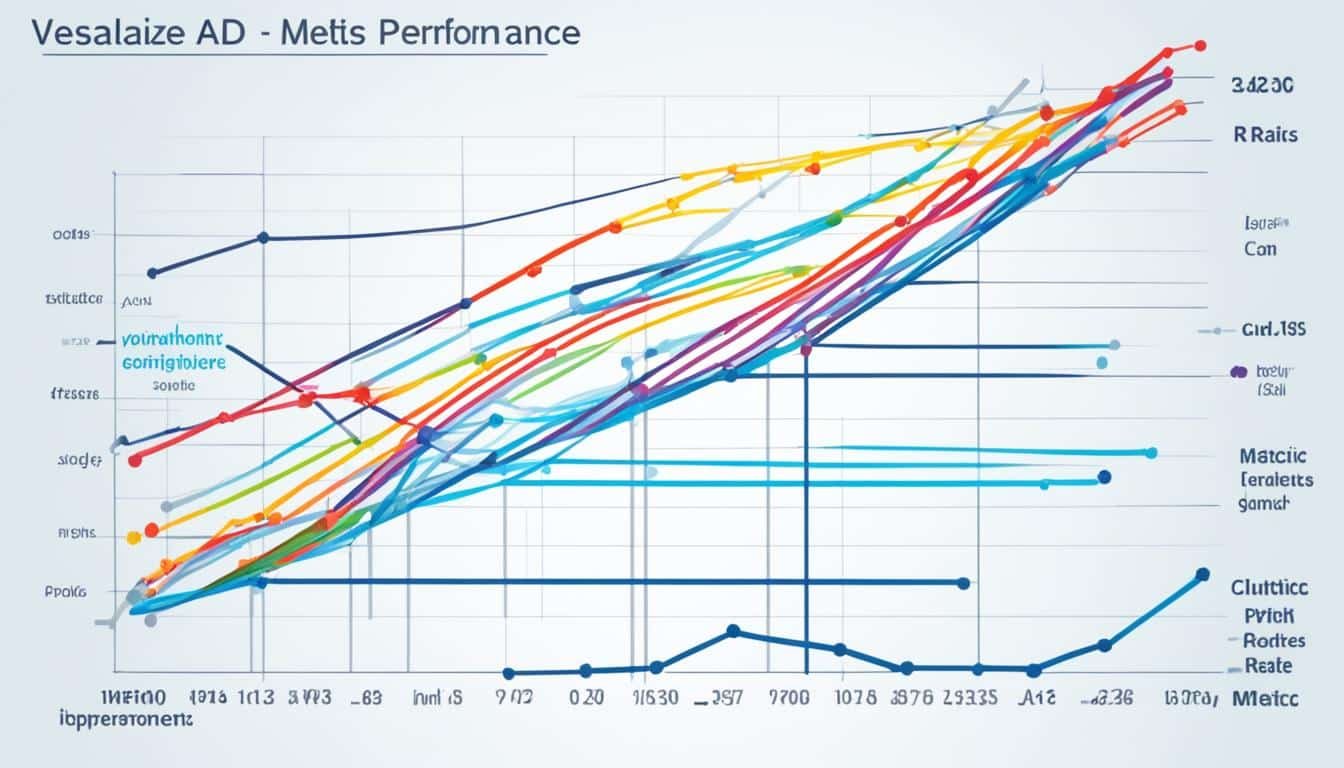Ad Performance AnalysisThe success of marketing campaigns isn’t just about coming up with cool ideas. It’s also about using data well. Campaign analytics helps marketers understand their campaigns better. They look at many numbers and insights to make smarter choices. This approach allows companies to see what their customers like, where they can do better, and how to spend money wisely. This guide will show you everything about campaign analytics, from important numbers to what you can do with them.
Key Takeaways
- Campaign analytics is essential for optimizing marketing strategies and maximizing ROI.
- Analyzing ad performance metrics, such as click-through rate, conversion rate, and cost per acquisition, can provide valuable insights.
- Integrating data from various sources and segmenting the audience are crucial for a unified view of campaign performance.
- A/B testing and conversion tracking are effective methods for identifying the most successful tactics.
- Measuring return on ad spend and understanding quality score can help inform future campaign planning and optimization.
What Is Campaign Analytics?
Campaign analytics involves collecting and analyzing data from marketing campaigns. It helps see how well these campaigns work. This understanding spans across various platforms like digital ads, emails, and social media. The aim is to get a clear view of how people engage with these campaigns.
Importance of Campaign Analytics
It helps answer key questions critical for marketing success. Is the audience responding? What channels bring the most results? How do campaigns affect the customer’s path? This analysis helps marketers make smarter choices. They can then improve how they target their audience, manage their budgets, and boost ROI.
By using campaign analytics, marketers can group their audience better. This leads to tailoring content specifically for different audiences. Such a personalized approach makes the customer’s experience more meaningful. It also makes ad spending and content more efficient and relevant.
“The data you collect from your marketing campaigns is your roadmap to success. Campaign analytics is the key to unlocking insights that drive better decisions and higher returns.”
| Key Benefits of Campaign Analytics | Metrics to Track |
|---|---|
|
|
Key Steps to Creating Useful Marketing Campaign Analytics

Making sense of data starts with a solid plan for marketing analytics. First, set your goals and choose KPIs that match. This could be for gaining awareness, selling more, or keeping customers coming back.
Define Objectives and KPIs
Start by setting clear marketing goals. Do you want more site visits or to grow your leads? Once you know your aims, pick KPIs like click-through rates or ROI to check your success.
Identify Relevant Metrics
Next, select metrics that reflect your objectives and KPIs. This could be clicks, customer value, and more. Using the right metrics helps understand how well your marketing is working.
Integrate Data Sources for a Unified View
Analytics need data from websites, social media, and CRMs. Bringing all these data sources together gives a full view. It includes connecting data, automating collection, and using a single dashboard for insights.
Segment Your Audience
Breaking your audience into different groups matters. It helps tailor your message to what each group likes. This step can boost your campaign’s success.
Implement A/B Testing
A/B testing is key. It lets you compare what works best in your ads, pages, or emails. Then, you improve your marketing based on real data.
“Data is the new oil, and analytics is the combustion engine that powers modern marketing.” – Dan Siroker, Co-Founder of Optimizely
By focusing on these steps, you can build an effective analytics setup. It will help you learn, refine, and hit your business targets.
Setting Up and Monitoring Conversion Tracking
![]()
Conversion tracking is key to a successful marketing campaign. It helps businesses see how well their ads are doing and what actions lead to good results. By setting up and checking conversion tracking, they can improve their ads and get better outcomes.
Choose Your Conversion Sources
Start by figuring out which conversion sources matter most for your business. For example, you might track:
- Website Conversions: Things like when someone buys, joins a newsletter, or clicks a button on your site.
- App Conversions: This includes actions in your app, like installs or purchases.
- Phone Conversions: You might count the calls from your ads or from clicking to call on your site.
After deciding on conversion sources, you have to set up the right tracking method. This makes sure you can keep an eye on these key actions.
Customize Conversion Actions
Your business might have special goals that need unique tracking. For instance, if you want to track form fills or video watches, you can customize these actions. This makes your tracking fit exactly with what you’re aiming for in marketing.
| Conversion Source | Tracked Actions |
|---|---|
| Website | Purchases, Newsletter Sign-ups, Button Clicks |
| App | App Installations, In-App Purchases |
| Phone | Calls from Ads, Click-to-Call Completions |
Monitoring your conversion tracking closely brings many benefits. It offers insights into how your ads are working. Plus, it helps you make smart changes to your marketing strategy based on real data.
Measuring Return on Investment (ROI)

Understanding your return on investment (ROI) is key for those using Google Ads. ROI shows the net profit to the costs. It tells you how much your ads are really benefiting your business.
In short, ROI is about knowing if the money spent on Google Ads is making your business money. This knowledge is important for any ads plan to work well.
To figure out ROI, you must keep an eye on factors like conversion value, cost per conversion, and overall profit. These figures help you see your ads’ success clearly. They guide your next steps in advertising.
If your ROI is high, it means your Google Ads plan is doing well. It’s bringing in good profits. But a low ROI means you might need to change your ads, or spend your budget differently. Always checking ROI helps ensure your ads are as effective as they can be.
| Metric | Description | Impact on ROI |
|---|---|---|
| Conversion Value | The total monetary value of the conversions generated by your Google Ads campaigns | Higher conversion value leads to a higher ROI |
| Cost per Conversion | The average cost of each conversion from your Google Ads campaigns | Lower cost per conversion leads to a higher ROI |
| Profit | The net revenue generated from the sales or actions driven by your Google Ads campaigns | Higher profit leads to a higher ROI |
Keep a close eye on these metrics. Make changes to your ads plan if needed. This way, you can get the most out of your Google Ads. Your business will grow more this way.
“Measuring ROI is essential for determining the true impact of your Google Ads investments. It’s the north star that guides your optimization efforts and ensures you’re spending your marketing budget wisely.”
Analyzing Search Terms and Keyword Performance

Knowing how your keywords and search terms perform is key for better Google Ads. The search terms report in Google Ads shows what searches made your ads appear. It helps you refine your keywords, match types, and find negative keywords.
By looking at the search terms report, you see how people interact with your ads. This insight guides you on which keywords to prioritize and how to refine your strategy. It also shows which negative keywords you should use. This improves how well your ads match what people are looking for.
Keyword Performance Insights
The search terms report gives you lots of info on keyword performance, like:
- Search terms: The actual queries that triggered your ads might not be the ones you aimed for.
- Match types: It shows if the search matched your keyword broadly, exactly, or in between.
- Impressions, clicks, and conversions: These numbers tell you how well each search term does.
- Cost and cost-per-conversion: Measures that show if a search term is worth the money.
Using this data, you can spot which terms work best and fix your match types. This helps you find where to add or remove keywords to make your ads more effective.
Refining Keyword Selection and Match Types
The search terms report is great for shaping your keyword and match type choices. You might find that broad match keywords are not quite right, wasting your ad budget. Changing these to a more specific type could make them work better.
It can also show you important search terms you didn’t target yet. Adding these to your list broadens your audience. Plus, it can help find negative keywords. These stop your ads from showing to people not interested in what you offer.
| Search Term | Match Type | Impressions | Clicks | Conversions | Cost | Cost-per-Conversion |
|---|---|---|---|---|---|---|
| digital marketing campaign analytics | Broad | 1,500 | 150 | 12 | $750 | $62.50 |
| how to measure campaign performance | Phrase | 950 | 90 | 8 | $450 | $56.25 |
| campaign analytics software | Exact | 720 | 80 | 7 | $400 | $57.14 |
Keep an eye on the search terms report. Use it to update your keywords smartly. This way, you can increase how well your Google Ads work and bring in more visitors who are truly interested in your offerings.
Understanding Quality Score

The quality score is a vital number in digital ads. It’s from Google. It shows how good and useful your ads are to people.
A high score means lower costs and better spots for your ads. But if your score is low, you might pay more and get worse spots. Knowing this is key to doing well with your ads.
The Four Pillars of Quality Score
There are four main parts to Google’s quality score:
- Ad Relevance: It’s about how well your ad fits what people are looking for.
- Landing Page Experience: This looks at how good, useful, and easy your webpage is when people click your ad.
- Expected Click-Through Rate (CTR): It’s about how likely people are to click your ad when they see it.
- Ad Position: This considers where your ad shows up in search results.
Working on these four areas can boost your quality score. This means better outcomes from your ads.
Strategies for Boosting Quality Score
To make your quality score better, try these tips:
- Make sure your ads and keywords match what people are searching for.
- Have landing pages that are helpful, match the ad, and are easy to use.
- Keep an eye on how your ads are doing and make them better to get more clicks.
- Try different positions for your ads and how much you bid to get better spots.
With these tips, you can raise your quality score. This will let you get more from your digital ad efforts.
| Metric | Importance | Impact on Quality Score |
|---|---|---|
| Ad Relevance | High | Directly influences the relevance of your ads to user queries. |
| Landing Page Experience | High | Determines the user-friendliness and relevance of the destination page. |
| Expected Click-Through Rate (CTR) | High | Reflects the likelihood of your ad being clicked by users. |
| Ad Position | Moderate | Affects the visibility and potential engagement of your ads. |
“Improving your quality score is a key lever for reducing your ad costs and increasing your ad visibility.”
Leveraging Google Ads Reports

Using Google Ads reports can greatly boost your marketing impact. They show a detailed view of how your ads perform, what users do, and if they buy. This info helps you make smart changes to your ad plans.
The first key step is linking your Google Ads with Google Analytics. This connection lets you see what happens after a user clicks your ad. Also, turning on auto-tagging in Google Ads helps match user actions with your campaigns. It gives you a full look at how customers interact with your ads.
These reports dive into many metrics, from how many times your ad was shown to the costs. Watching these numbers can show you trends and places to improve. Knowing what your audience looks for and uses helps fine-tune your ads. You can adjust what you show and how you bid to get better results.
Using Google Ads insights, you can better your strategy. Improve your ads and who sees them to get more for your money. This way, you make choices based on solid data. You can also keep up with what works in the fast world of online ads.
| Metric | Description | Importance |
|---|---|---|
| Impressions | The number of times your ad is displayed to users | Indicates the reach and visibility of your ads |
| Clicks | The number of times users click on your ad | Measures user engagement and interest in your offerings |
| Click-Through Rate (CTR) | The ratio of clicks to impressions | Reveals the effectiveness of your ad copy and targeting |
| Conversions | The number of users who take a desired action, such as making a purchase or submitting a lead form | Directly measures the success of your campaigns in driving desired outcomes |
| Cost-per-Acquisition (CPA) | The cost incurred for each conversion | Helps assess the efficiency and profitability of your ad campaigns |
By using Google Ads reports well, you power up your digital ads. You can make your campaigns stronger and get more out of your budget.
Ad Performance Analysis
Looking closely at ad performance is key to make your marketing better and reach your goals. Monitor important data and connect it to what you want to achieve. This helps you see which channels work best and adjust your methods based on solid data.
Start by setting clear marketing goals and which KPIs you’ll watch. You might look at things like how many people click, how often they buy, and the cost of getting those buyers. This data can show you how well your ads do on different channels.
Then, dig into how each advertising channel is doing. Check out how search, social media, display, and email ads are performing. This tells you where to focus your money and how to make your efforts more successful.
| Channel | Impressions | Clicks | Conversions | Cost-per-Acquisition | Return on Investment (ROI) |
|---|---|---|---|---|---|
| Search | 250,000 | 12,500 | 1,500 | $20 | 180% |
| Social Media | 500,000 | 25,000 | 2,000 | $15 | 220% |
| Display | 750,000 | 30,000 | 1,800 | $25 | 150% |
| 100,000 | 5,000 | 800 | $18 | 190% |
Looking at this data, social media ads have the best ROI, but display ads cost more to bring in new customers. This insight is key for planning ahead and using your resources wisely.
Keep in mind, ad performance analysis is something you do all the time, not just once. Staying on top of your campaigns and making them better will help you win in the market.
Monitoring Digital Channel Performance

It’s key to track how well your digital marketing channels work. This helps see their role in bringing sales. By watching metrics through the buyer’s path, from early site visits to final sales, gaps can be found. This way, you can fine-tune your marketing plans.
To keep an eye on your digital channel performance, stick to these steps:
- Set solid objectives and KPIs for every channel. For example, aim to boost site visits, attract more leads, or uplift conversion rates.
- Choose which metrics to watch. This might zip from organic search traffic to email marketing results.
- Blend data from tools like web analytics and CRM systems. This gives you a full look at your sales funnel.
- Group your audience to see how various personas and buyer journeys perform.
- Use A/B testing to keep boosting your digital marketing strategies. This helps find new opportunities.
Keeping tabs on your digital channels and studying the data lets you make wise choices. This, in turn, bumps up your leads and boosts your sales.
“The key to success in digital marketing is to continuously analyze your data, identify areas for improvement, and adapt your strategies accordingly.”
Planning for the Future with Performance Insights

Looking at past ad performance helps plan for the future. Using data-driven insights, marketers can plan better. They use data to improve future campaigns and strategies.
The real power comes from turning old results into future actions. There are key steps to do this:
- Look at past performance to spot trends. Use these to set better goals.
- Find what’s working and what’s not in your campaigns. This will help you make future plans better.
- Use insights from data to choose where to spend your money, which channels to pick, and what to say.
- Make sure your future plans fit with your larger business goals. This keeps your strategy strong.
This data-driven method changes ad analysis into a tool for the future. It helps meet marketing goals. It also boosts long-term business success.
“The key to unlocking the full potential of your ad performance analysis lies in your ability to translate past results into actionable future planning.”
Ad analysis is valuable for shaping future plans with insights. Taking a complete look can open doors. This can keep you in front of your rivals.
Automating Data Collection for Efficient Analysis

In the world of digital marketing, it’s key to gather, consolidate, and analyze data fast. Manually doing this can eat up a lot of time and effort. This slows down getting real-time insights and reacting quickly to trends.
The rise of data automation and reporting tools change the game. Marketers use these to collect and consolidate data quicker. This gives them more time to focus on important strategies.
Streamlining the Data Collection Process
Data automation tools easily work with many marketing platforms. They gather data from places like social media and e-commerce. Then, they show it all in one place for you to check easily.
- Reduce manual data entry and eliminate the risk of human error
- Gain real-time insights by automating the data collection process
- Improve efficiency and productivity by automating repetitive tasks
- Consolidate data from multiple channels for a comprehensive data-driven decision making approach
Using data consolidation lets marketers spend more time on insights and strategies. They can spot trends and create smarter plans to improve their campaigns.
“Automating data collection and reporting lets us focus on strategic analysis. It saves us from doing too much manual work. This has really helped our marketing team.”
– John Doe, Marketing Manager at XYZ Corporation
The digital world is always changing. Being able to gather and analyze data efficiently is essential. With data automation, marketers can work better. They get valuable insights fast and make solid decisions for their campaigns.
Also Read : What Are The Legal Regulations Surrounding Advertising?
Conclusion
In today’s world, studying ad performance is key for businesses wanting to do better in marketing. By analyzing data, marketers can choose what their audience likes. This helps them spend their money well.
We looked at how to make the best of campaign analysis in this guide. This includes setting goals and picking the right things to measure. It also involves using A/B testing and keeping an eye on things like how many people buy after they see an ad.
Remember, looking at ad success never stops. It’s something that always needs to get better to fit the changing market. Using data and smart tools, companies can check their marketing efforts more easily. This lets them improve and grow over time.
FAQs
What is campaign analytics and why is it important?
Campaign analytics is a method that collects, measures, and analyzes data from marketing efforts. It helps understand how people engage with your campaign. This allows for better strategies and higher returns on investment.
What are the key steps to creating useful marketing campaign analytics?
Key steps to useful analytics include setting clear goals and choosing important metrics. Also, you should gather data from different sources, divide your audience, and test different strategies.
How do I set up and monitor conversion tracking?
To start tracking conversions, choose what you want to measure like purchases or sign-ups. It’s essential to track these activities to see the impact of your ads.
How do I measure return on investment (ROI) for my marketing campaigns?
To measure ROI, look at your profit compared to the costs. This metric is key to know if your marketing activities are bringing in profits.
How can I analyze search term and keyword performance?
In Google Ads, the search terms report shows the exact queries that triggered your ads. This insight is critical for choosing the right keywords and improving ad relevance.
What is Google’s Quality Score and why is it important?
Google’s Quality Score shows how well your ads match user searches. A high score leads to lower costs and better ad placement. Google prefers relevant ads for users.
How can I leverage Google Ads reports to gain insights?
First, link your Google Ads and Google Analytics accounts. Enable auto-tagging for the fullest view of your campaign’s performance. This setup unlocks valuable insights.
How do I conduct thorough ad performance analysis?
Analyzing ad performance requires tracking KPIs and aligning them with goals. It helps spot the best channels and make smart choices for better campaign results.
How can I monitor the performance of my digital channels?
Keep an eye on digital channel performance to see each one’s impact. This lets you find and fix any flaws in your marketing plan.
How can I use data-driven insights to plan for the future?
Use insights from past campaigns to shape future strategies. This approach helps make better plans and reach your marketing goals more effectively.
How can I automate data collection for more efficient ad performance analysis?
Using automated tools like Improvado for data collection saves time and offers live insights. This supports smarter, data-backed decisions for your marketing.
Source Links
- https://improvado.io/blog/campaign-analytics
- https://ads.google.com/intl/en_us/home/resources/articles/how-to-analyze-google-ads-successfully/
- https://reportei.com/en/digital-performance-analysis/





